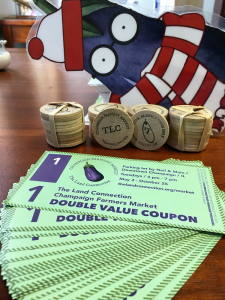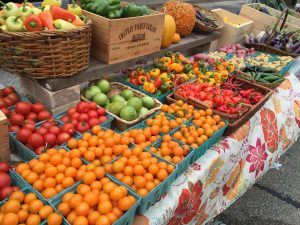 Last week I got to make my National Public Radio debut, as a guest on WILL’s show The 21st with Niala Boodhoo, along with Catherine Dunlop (manager of the Downtown Bloomington Farmers Market) and Natalie Moore (WBEZ Chicago’s South Side bureau reporter). And of course, ever since the interview, I keep thinking of additional points I could have made, so I’ll make some of them here.But first…listen to the interview!
Last week I got to make my National Public Radio debut, as a guest on WILL’s show The 21st with Niala Boodhoo, along with Catherine Dunlop (manager of the Downtown Bloomington Farmers Market) and Natalie Moore (WBEZ Chicago’s South Side bureau reporter). And of course, ever since the interview, I keep thinking of additional points I could have made, so I’ll make some of them here.But first…listen to the interview!
A little over two years ago I wrote my blog about the Supplemental Nutrition Assistance Program (SNAP) at the farmers market for the first time. I was poking through some data about the impact on farmers markets in Illinois when they started accepting SNAP. Within a span of just 6 years Illinois farmers markets went from taking in just over $1,500 in 2008, to almost $400,000 in 2014 (no, there’s not an extra zero in there). This is a huge shift–Illinois went from second-to-last in the nation when it comes to SNAP spending at farmers markets up to #11! That’s a lot of money going into the pockets of our local farmers, and with the increase in SNAP matching programs over the past few years, thanks to programs like Link Up Illinois, the economic impact for our local farmers is even greater.
I had been enjoying their coverage of the 2018 Farm Bill, but was also frustrated by the way that some guests would describe SNAP recipients. When politicians point out the number of SNAP-eligible people who are working age, and then talk about how we need to get those people to work, it feels like the implication is that most of them are not working. Which is really frustrating, because it colors the public perception of this very valuable program, in turn hurting public support for SNAP. In Champaign County, for example, 87% of all SNAP households have at least one family member working. 28% of all Champaign County families receiving SNAP have at least 2 members of the household working. That’s not even 87% of all SNAP recipients classified as “able bodied adults without dependents” (the classification of SNAP recipients who can only receive benefits for 3 months unless they meet specific work, eductation, training, or volunteer requirements), that’s 87% of all SNAP households. In Champaign County, SNAP recipients are definitely working. Not only does this program help people get enough to eat, but as it does, that money goes directly into our local economy, creating jobs and opportunities in our communities. We all win.
 I’ve thrown out all kinds of statistics about our SNAP program at the Champaign Farmers Market (check out our annual report to see the impact of the first three years of our SNAP program); I’ll spare you the numbers right now. But when I think back to the impact of these incentive programs, I think about my early years at the Urbana Market at the Square (which I worked for the first time 7 years ago today!), when Link matching first started. A few times we ran out of grant funds, and had to break the bad news to shoppers that we couldn’t double. But very often, customers who were used to swiping for $20 and getting that extra $20 to spend would decide to go ahead and swipe for $40. Buying fresh food at the farmers market had become an integral part of their shopping routine, and they were still going to make it work. This is precisely what these programs are designed to do: make buying fresh produce more affordable and attractive, so that it feels accessible to everyone.
I’ve thrown out all kinds of statistics about our SNAP program at the Champaign Farmers Market (check out our annual report to see the impact of the first three years of our SNAP program); I’ll spare you the numbers right now. But when I think back to the impact of these incentive programs, I think about my early years at the Urbana Market at the Square (which I worked for the first time 7 years ago today!), when Link matching first started. A few times we ran out of grant funds, and had to break the bad news to shoppers that we couldn’t double. But very often, customers who were used to swiping for $20 and getting that extra $20 to spend would decide to go ahead and swipe for $40. Buying fresh food at the farmers market had become an integral part of their shopping routine, and they were still going to make it work. This is precisely what these programs are designed to do: make buying fresh produce more affordable and attractive, so that it feels accessible to everyone.


